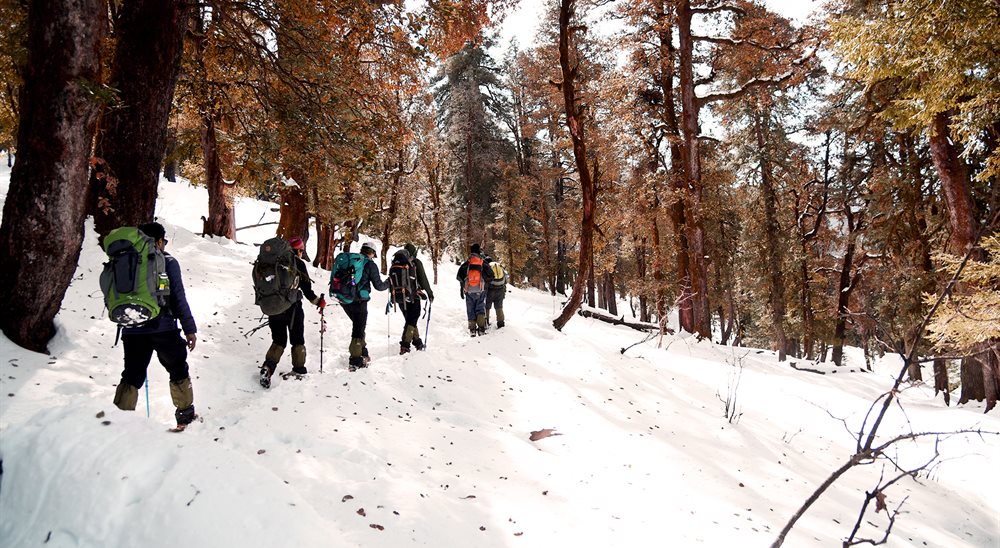Nestled in the Garhwal Himalayas of Uttarakhand, India, the Kedarkantha Trek is an ideal adventure for beginners seeking an exhilarating yet manageable trekking experience. Known for its stunning vistas, snow-capped peaks, and rich flora and fauna, the Kedarkantha trek offers an unparalleled journey through dense forests, quaint villages, and expansive meadows.
Why Choose the Kedarkantha Trek?
The Kedarkantha trek is perfect for beginners due to its moderate difficulty level, well-defined trails, and the relatively short duration of 4-6 days. It provides an excellent introduction to high-altitude trekking without being overly strenuous. Additionally, the trek is accessible year-round, with each season offering unique scenic beauty. Winter, however, is particularly popular as the trail transforms into a snowy wonderland, providing a magical trekking experience.
Best Time to Visit
While the Kedarkantha trek can be undertaken at any time of the year, the best periods are from December to April for winter treks and from May to June and September to November for more temperate weather. Winter treks offer a snow-covered landscape, while the summer and autumn months provide lush greenery and vibrant flora.
How to Reach Kedarkantha
-
By Air
The nearest airport is Jolly Grant Airport in Dehradun, approximately 200 kilometres from Sankri, the base camp for the Kedarkantha trek. From the airport, one can hire a taxi or take a bus to reach Sankri.
-
By Train
The closest railway station is Dehradun Railway Station. From here, buses and taxis are available to Sankri, which is about 220 kilometres away.
-
By Road
Regular buses and taxis operate from Dehradun, Mussoorie, and other major cities in Uttarakhand to Sankri. The journey by road is scenic, offering glimpses of the picturesque landscapes of the Garhwal region.
Trek Itinerary
Day 1: Dehradun to Sankri
The journey begins with a drive from Dehradun to Sankri, a picturesque village and the starting point of the trek. The drive takes around 8-10 hours, covering a distance of approximately 200 kilometres. Overnight stay in Sankri.
Day 2: Sankri to Juda Ka Talab
The trek from Sankri to Juda Ka Talab is about 4 kilometres and takes 4-5 hours. The trail passes through dense pine forests, with occasional clearings offering breathtaking views of the surrounding mountains. Juda Ka Talab is a serene, high-altitude lake where trekkers camp for the night.
Day 3: Juda Ka Talab to Kedarkantha Base Camp
From Juda Ka Talab, the trek to Kedarkantha Base Camp is around 4 kilometres, taking approximately 3-4 hours. The path ascends gradually, passing through pine and oak forests, expansive meadows, and offering stunning views of the Himalayan peaks. Camp overnight at the base camp.
Day 4: Kedarkantha Base Camp to Summit and Back to Hargaon
The trek to the summit of Kedarkantha starts early in the morning. The 6-kilometre trek takes about 6-7 hours. The summit offers panoramic views of the snow-clad mountains, including Swargarohini, Bandarpoonch, and Black Peak. After spending some time at the summit, trek back to Hargaon, where you camp for the night.
Day 5: Hargaon to Sankri and Drive Back to Dehradun
The final day involves a descent from Hargaon to Sankri, covering about 6 kilometres in 4 hours. After reaching Sankri, a drive back to Dehradun marks the end of the trek.
Essential Gear and Equipment
Clothing
- Thermal Wear: Essential for the cold nights.
- Trekking Pants: Quick-dry and comfortable.
- Fleece Jackets and Down Jacket: For insulation.
- Waterproof and Windproof Jacket: To protect against rain and wind.
- Trekking Shoes: Sturdy, waterproof, and with good grip.
- Woolen Cap, Gloves, and Socks: To keep warm.
Accessories
- Backpack: 50-60 litres with rain cover.
- Trekking Poles: Helpful for balance on uneven terrain.
- Headlamp or Torch: With extra batteries.
- Water Bottles or Hydration Pack: To stay hydrated.
- Sunglasses and Sunscreen: To protect against sun and snow glare.
Camping Gear
- Tent and Sleeping Bag: Usually provided by trekking companies.
- Sleeping Mat: For extra comfort.
First Aid and Personal Items
- First Aid Kit: With essential medicines and bandages.
- Personal Toiletries: Biodegradable if possible.
- Snacks and Energy Bars: For quick energy boosts.
Physical Preparation and Tips
Fitness
A moderate level of fitness is required for the Kedarkantha trek. Regular cardiovascular exercises such as running, swimming, or cycling, along with strength training, will prepare your body for the trek. It’s advisable to start training at least a month before the trek.
Acclimatization
Proper acclimatisation is crucial to prevent altitude sickness. It’s recommended to spend a day in Sankri before starting the trek to adjust to the altitude. Stay hydrated and take it slow to allow your body to adapt to the changing elevation.
Packing Smart
Pack light but ensure you have all the essentials. Organise your gear in waterproof bags to keep them dry. Carrying a portable charger or extra batteries for electronic devices can be very useful.
Environmental Responsibility
The pristine beauty of the Kedarkantha trek comes with the responsibility of preserving it. Adhere to the principles of Leave No Trace:
- Dispose of Waste Properly: Carry back all non-biodegradable waste.
- Respect Wildlife: Observe animals from a distance.
- Minimise Campfire Impact: Use a portable stove for cooking.
- Be Considerate of Other Trekkers: Maintain the tranquillity of the environment.
Conclusion
The Kedarkantha trek is an unforgettable adventure that offers a perfect blend of natural beauty, physical challenge, and cultural experience. Ideal for beginners, this trek not only introduces you to the joys of high-altitude trekking but also leaves you with memories of a lifetime. So pack your bags, lace up your boots, and embark on this magnificent journey into the heart of the Himalayas.








